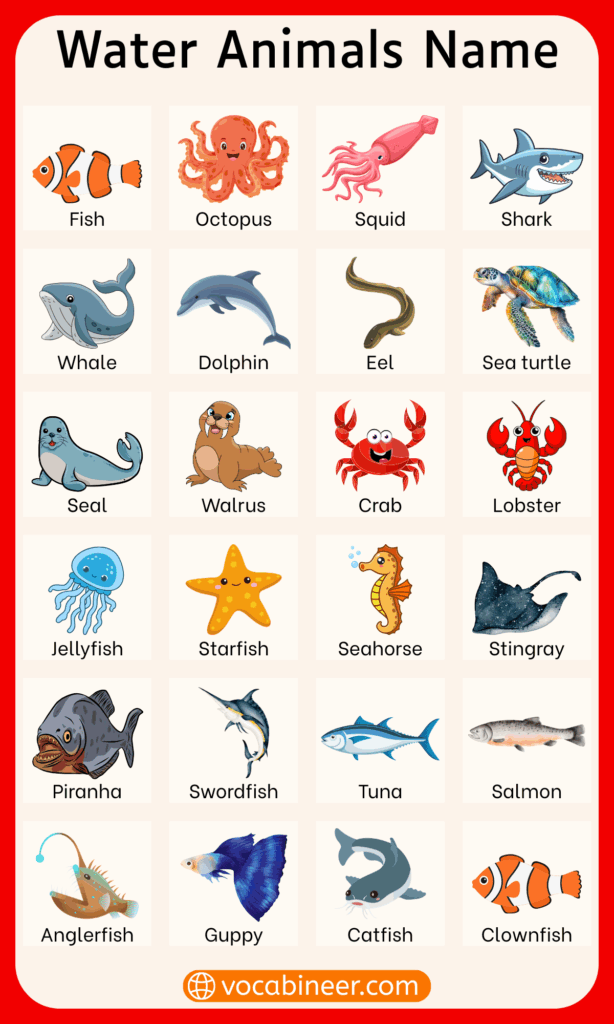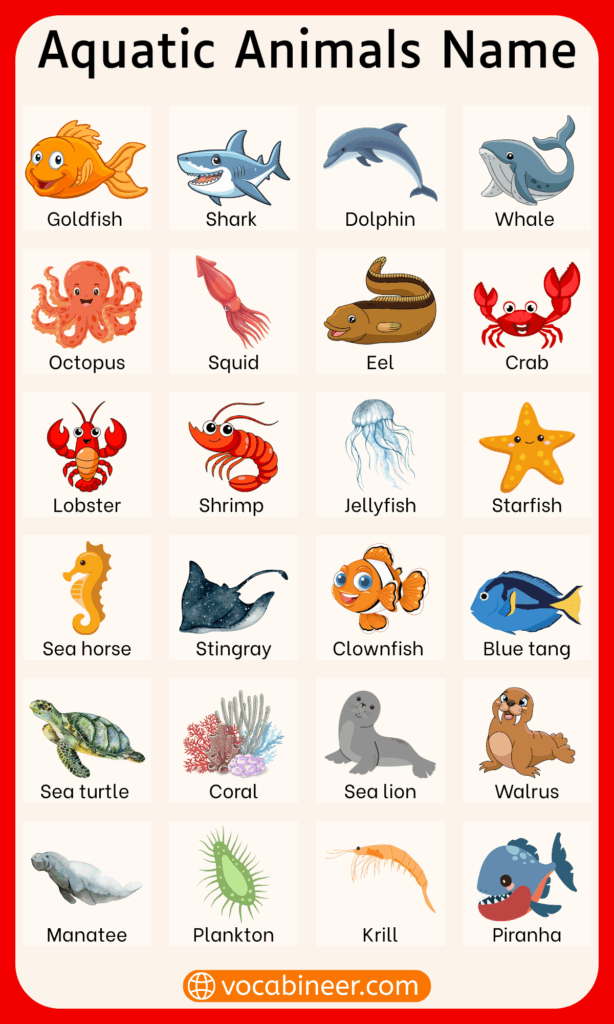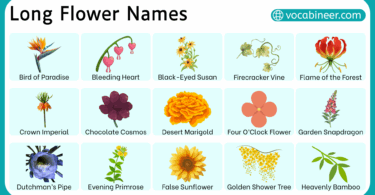Water animals are creatures that live in oceans, rivers, and lakes, and they include many fascinating species. From fish and reptiles to mammals, their adaptations allow survival in water-based habitats worldwide. Aquatic animals is another name often used for the same group, covering dolphins, turtles, crabs, and many other species people recognize. By learning water animals name with their pictures, readers can easily connect species with their names and use them in daily conversations about science, travel, or education.
In This Page
List of Common Water Animals Name
Water animals live in oceans, rivers, and lakes. These common water animals in English include marine and freshwater creatures known for their unique ways of moving and communicating.
- Fish: Small aquatic animals that breathe through gills and make soft bubble or clicking sounds underwater.
- Whale: Large sea mammals known for their long, deep songs that travel across great ocean distances.
- Dolphin: Intelligent marine mammals that produce clicking sounds to talk and find objects underwater.
- Seal: Playful sea animals that make barking noises while resting or calling to their group.
- Sea Lion: Powerful swimmers that use barking and grunting sounds to communicate on the shore.
- Octopus: Soft-bodied sea creatures that move quietly, sometimes producing gentle suction sounds with their tentacles.
- Crab: Hard-shelled animals that make clicking noises with their claws while moving along the seafloor.
- Lobster: Large crustaceans known for their cracking or tapping sounds when rubbing their claws.
- Jellyfish: Floating animals that make no sound but move gracefully through water using pulsing motions.
- Shrimp: Small sea animals that make snapping or popping sounds when their claws close quickly.
- Starfish: Sea creatures that move slowly on the ocean floor, using tiny feet without making any sound.
- Clam: Shellfish that stay buried under sand, producing soft snapping sounds when closing their shells.
- Turtle: Reptiles that live both in water and on land, making gentle grunting sounds.
- Manatee: Large, gentle sea mammals that make chirping or whistling noises to stay in contact underwater.
- Squid: Fast-moving sea animals that release ink for protection and make faint suction sounds while swimming.
- Otter: Playful water mammals that make chirping and whistling sounds to communicate with family members.
- Seahorse: Tiny fish-like animals that make soft clicking sounds when feeding or interacting.
- Penguin: Birds that live near water, producing braying or honking sounds on land and near the shore.
- Walrus: Large Arctic animals that make grunting and bellowing noises to show strength or warn others.
- Shark: Silent predators of the ocean that do not make sounds but sense vibrations in water to locate prey.

Types of Aquatic Animals
Aquatic animals live in different kinds of water environments. Some live only in salt water, some in fresh water, and some can survive in both.
- Marine Animals: Live in oceans and seas. Examples include whales, sharks, octopuses, and dolphins that breathe or move in salt water.
- Freshwater Animals: Inhabit rivers, ponds, and lakes. Creatures like fish, frogs, turtles, and crabs thrive in clean fresh water.
- Amphibious Animals: Can live both on land and in water. Frogs, toads, salamanders, and newts switch between both habitats easily.
- Estuarine Animals: Found where rivers meet seas, in mixed salt and fresh water. Crabs, mangrove fish, and snails are common here.
- Deep-Sea Animals: Live far below sunlight zones. Anglerfish, squid, and giant jellyfish survive under high pressure and cold temperatures.
- Coral Reef Animals: Small sea creatures like clownfish, sea urchins, and anemones that live among coral structures.
Fish That Live in Water
Fish are the most common aquatic animals found in seas, rivers, and lakes. They breathe through gills, swim with fins, and come in many shapes, sizes, and colors.
- Goldfish: Small, colorful freshwater fish often kept as pets; they move quietly and make soft bubble sounds in water.
- Shark: Large marine predators that move swiftly; they do not make sounds but sense vibrations to find prey.
- Salmon: Strong swimmers that live in salt and fresh water; known for their long migration journeys.
- Tuna: Fast-moving ocean fish that travel in schools; they are important for food and ocean balance.
- Clownfish: Brightly colored fish that live among coral reefs; they make faint popping sounds when defending territory.
- Catfish: Freshwater fish with whisker-like feelers; they make low grunting or croaking noises when disturbed.
- Trout: Live in cool freshwater streams; valued for fishing and known for their quick swimming speed.
- Swordfish: Large fish with a long, pointed snout; they swim fast near ocean surfaces.
- Carp: Found in rivers and ponds; calm swimmers that produce small clicking sounds while feeding.
- Eel: Long, snake-like fish that live in both salt and fresh water; they move silently through mud and rocks.
- Mackerel: Shiny ocean fish that swim in groups; known for fast movement and shimmering skin.
- Seahorse: Tiny, upright-swimming fish that make faint clicking sounds while eating or interacting.
- Angelfish: Bright tropical fish found in coral reefs; move slowly and are popular in aquariums.
- Guppy: Small, colorful freshwater fish that breed quickly and live peacefully in aquariums.
- Pufferfish: Can inflate its body for protection; some species make humming or vibrating noises underwater.
- Snapper: Ocean fish with strong jaws; known for quick reactions and sharp biting sounds when feeding.
- Marlin: Large saltwater fish related to swordfish; famous for their pointed bills and long-distance swimming.
- Anchovy: Small schooling fish found near the ocean surface; play an important role in marine food chains.
- Cod: Cold-water fish known for mild taste; found in deep seas and swim slowly near the seabed.
- Betta Fish: Bright and active aquarium fish that flare fins; sometimes make popping sounds at the water surface.
Marine Mammals in Water
Marine mammals are warm-blooded animals that live mainly in the ocean. They breathe air through lungs but spend most of their lives swimming, diving, and hunting underwater.
- Whale: Giant ocean mammals that make long songs and calls to communicate across large distances.
- Dolphin: Intelligent and playful animals that use clicking and whistling sounds for communication and echolocation.
- Seal: Semi-aquatic mammals with flippers; make barking or grunting sounds when calling to others.
- Sea Lion: Loud, social animals that use barks and growls to interact and defend their space.
- Walrus: Large Arctic mammals with tusks; make deep grunts and bellows while resting on ice or beaches.
- Manatee: Gentle, slow-moving animals that produce chirping or whistling sounds to keep in contact underwater.
- Otter: Playful swimmers that make chirping or squeaking sounds when excited or communicating.
- Polar Bear: Strong swimmers that live on ice and in water; make roaring and growling sounds while hunting.
- Beluga Whale: Known as “sea canaries” for their high-pitched whistles and songs under the water.
- Narwhal: Arctic whales with long tusks; make clicks, whistles, and knocks for navigation and group calls.
- Orca: Large predatory dolphins that make pulses, clicks, and screeches while hunting or traveling in pods.
- Sea Otter: Use chirps and squeals to communicate and crack shells with stones while floating on their backs.
Reptile Animals That Live in Water
Reptiles that live in water have special features like scaly skin and strong limbs for swimming. These aquatic reptiles in English spend most of their time near or inside water.
- Crocodile: Large reptiles that live in rivers and swamps; make hissing or growling sounds while guarding their territory.
- Alligator: Similar to crocodiles but found mostly in freshwater; make bellows and roars to attract mates or warn others.
- Turtle: Gentle reptiles that can live both on land and in water; make grunting or hissing sounds.
- Sea Turtle: Marine reptiles with flippers; move silently but make low grunts during nesting or movement.
- Water Snake: Found in ponds and rivers; make soft hissing sounds and swim smoothly on the water surface.
- Iguana: Often live near rivers; can swim and make hissing or clicking sounds when threatened.
- Caiman: Small relatives of alligators; make chirping or bellowing sounds to communicate with their young.
- Monitor Lizard: Semi-aquatic reptiles that swim well and make deep hissing or snorting noises when alarmed.
- Terrapin: Freshwater turtles with hard shells; stay quiet but sometimes produce grunts when moving or feeding.
- Gharial: Long-snouted crocodiles found in rivers; make buzzing or humming sounds, especially males during mating calls.

Amphibians as Aquatic Animals
Amphibians are cold-blooded animals that live both in water and on land. These amphibians as aquatic animals breathe through moist skin and lay eggs in water.
- Frog: Well-known amphibians that live in ponds and make croaking or ribbit sounds, especially during the rainy season.
- Toad: Similar to frogs but with dry, bumpy skin; make deep croaks or trills when calling mates.
- Salamander: Slender, soft-skinned amphibians that live near water; move quietly and make faint clicking or squeaking sounds.
- Newt: Small amphibians that swim gracefully and make light humming or vibrating sounds while moving underwater.
- Caecilian: Worm-like amphibians that burrow in mud and stay mostly underwater; produce vibration-based sounds for communication.
- Tree Frog: Amphibians that can live on land and in water; known for high-pitched chirping calls at night.
- Axolotl: Unique amphibians that stay underwater their entire lives; make soft clicking sounds when feeding or moving.
- Bullfrog: Large frogs with deep croaks that can be heard across long distances near lakes or marshes.
- Glass Frog: Transparent-skinned amphibians that make soft trilling sounds while hiding among wet leaves near rivers.
- Fire Salamander: Brightly colored amphibians found near streams; remain mostly silent but can make squeaky defensive sounds.
Crustaceans in Water
Crustaceans are water-dwelling animals with hard shells and jointed legs. These aquatic crustaceans in English live in oceans, rivers, and lakes, playing an important part in aquatic food chains.
- Crab: Common crustaceans with claws that make clicking or tapping sounds while walking on rocks or defending territory.
- Lobster: Large ocean crustaceans with strong claws; make rubbing or creaking sounds when moving or snapping their pincers.
- Shrimp: Small sea animals that produce snapping or popping sounds when closing their claws quickly.
- Prawn: Similar to shrimp but larger; make soft tapping sounds while swimming and feeding in shallow water.
- Barnacle: Small crustaceans that attach to rocks and ships; stay silent but move their tiny legs to filter food.
- Krill: Tiny shrimp-like creatures that move in groups; make faint vibrating sounds while swimming in the ocean.
- Hermit Crab: Use empty shells for protection and make scratching or clicking sounds when crawling or changing shells.
- Crayfish: Freshwater crustaceans similar to lobsters; make rasping sounds by rubbing their body parts together underwater.
- Woodlouse: Land crustaceans that prefer damp places; move quietly and produce rustling sounds on moist soil.
- Amphipod: Small transparent crustaceans that swim near the surface and make faint popping sounds during feeding.
Mollusks as Aquatic Animals
Mollusks are soft-bodied aquatic animals that often have shells for protection. These creatures live in both fresh and salt water, moving slowly and filtering food from their surroundings.
- Octopus: Intelligent mollusks with eight arms; make gentle suction sounds while moving and use ink to escape danger.
- Squid: Fast-swimming sea mollusks; communicate with color changes and make faint suction sounds while swimming.
- Snail: Small mollusks with coiled shells; move slowly and make soft scraping sounds while eating plants underwater.
- Slug: Shell-less mollusks that live in damp places; move quietly using a slippery, smooth body surface.
- Clam: Burrowing mollusks with two shells; make snapping sounds when closing their shells tightly underwater.
- Oyster: Shellfish that filter water for food; make clicking or rattling sounds when their shells move.
- Mussel: Freshwater and saltwater mollusks; remain quiet but move slowly to filter plankton from the water.
- Scallop: Sea mollusks that can swim by clapping shells; make clapping sounds as they move.
- Cuttlefish: Relatives of squid; change color to communicate and make light suction sounds when hunting.
- Nautilus: Ancient mollusks with spiral shells; swim slowly in deep seas, remaining silent while using jet propulsion.
Echinoderms Found in Water
Echinoderms are marine animals that live on the ocean floor. These creatures have spiny skin and move using small tube feet instead of fins or limbs.
- Starfish: Also called sea stars; move slowly using tube feet and stay silent while feeding on clams and coral.
- Sea Urchin: Round, spiny creatures that scrape algae from rocks, making faint scratching or rubbing sounds underwater.
- Sea Cucumber: Soft-bodied echinoderms that crawl along the sea floor; stay mostly silent while cleaning and recycling nutrients in sand.
- Brittle Star: Fast-moving relatives of starfish; make rustling or scraping sounds when sliding across the seabed.
- Feather Star: Graceful echinoderms with feathery arms that wave in water; move quietly while filtering plankton.
- Sand Dollar: Flat echinoderms found in shallow seas; move gently and produce soft rubbing sounds in sand.
- Basket Star: Large, branching echinoderms that unfold their arms at night to catch food, moving quietly under water currents.
- Sea Lily: Ancient deep-sea echinoderms attached to rocks; sway with water flow and make no detectable sound.
- Sea Biscuit: Thick-bodied echinoderms similar to sand dollars; remain silent while buried in sandy seabeds.
- Heart Urchin: Heart-shaped echinoderms that live in soft sand; move quietly while digging and feeding on small particles.
Other Interesting Water Animals
Some aquatic animals do not fit neatly into main groups but remain well-known.
- Seahorse
- Jellyfish
- Stingray
- Electric Eel
- Swordfish
- Blue Whale
- Dugong
- Sea Snake
- Sea Anemone
- Coral
- Sea Sponge
- Manta Ray
- Sea Hare
- Lionfish
- Moray Eel
- Blobfish
- Sea Dragon
- Horseshoe Crab
- Lamprey
- Plankton
Conclusion
Learning water animals name with their pictures helps learners connect species with their names. From fish and amphibians to reptiles, mammals, and invertebrates, aquatic animals form a vital part of ecosystems. Knowing their names makes conversations in classrooms, travel, and nature studies easier and more meaningful.
FAQs about Water Animals Name
There are thousands of water animals, but they can be grouped into main types such as fish, mammals, reptiles, amphibians, mollusks, crustaceans, and echinoderms.
It helps in school learning, travel conversations, science studies, and daily English practice, making communication about ocean life easier and more accurate.
Some of the most common ones include fish, dolphins, whales, turtles, crabs, jellyfish, and sharks, all of which are widely recognized worldwide.
The blue whale is the largest animal on Earth, while the whale shark is the biggest fish. Both live in oceans and are part of marine biodiversity.
Yes, pictures make it much easier for children to remember and identify different animals, improving both vocabulary and interest in aquatic life.
Read More




